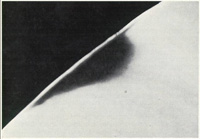HYGIENE
The practice of dentistry by all members of the clinical team involves static posture, precise and repetitive motions, long work hours, and suboptimal ergonomics.1,2 The prevalence of musculoskeletal disorders (MSDs) among dentists and dental hygienists can range from 64% to 93%, with prolonged static postures (PSPs) and repetitive movements being listed as major risk factors.3-5 More troubling were the results of a study in the United Kingdom that found that MSDs were the most frequent cause of premature retirement among dentists.6 The World Health Organization defines work-related MSDs as “disorders or injuries affecting muscles, tendons, joints, ligaments, and bones mainly caused by mechanical overload of the respective biological structures. Potential overload of tissues results from high intensity forces or torques acting on and inside the body.”7 The types of MSDs in dentistry broadly fall into 3 categories: neck and shoulder disorders, hand and wrist disorders, and back disorders.2
Focusing specifically on hand and wrist disorders, dentists and dental hygienists suffer from more hand, wrist, and arm pain than the general population.8-10 Carpal tunnel syndrome (CTS) is the most common MSD within the hand and wrist disorder category and is caused by compression of the median nerve, causing symptoms to include numbness, tingling, or pain in the thumb, index finger, middle finger, and half of the ring finger. There are many suspected causes of CTS, and besides a history of trauma to the wrist, contributing factors can include an overactive pituitary gland, an underactive thyroid gland, and rheumatoid arthritis.10 Females are 3 times more likely to develop CTS, with diabetic and obese individuals also being at increased risk.11 General work-related risk factors for CTS include mechanical stress to the hand and wrist, forceful exertion, repetitive motions, and PSP.7 In dentistry, activities such as forceful gripping of small instruments, flexing the wrist forward, vibration, and repetitive motions for long periods of time have been implicated in the development of CTS symptoms.8,11
 | 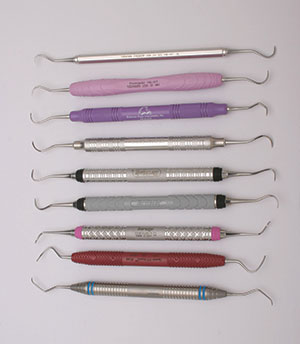 |
| Figure 1. The use of big-handled instruments (pictured: PremierAir Probex Explorer [Premier Dental Products]) and proper finger rests can help reduce muscle workload and pinch force. | Figure 2. A variety of dental hygiene instruments demonstrates the trend away from small-diameter handles toward larger-diameter, textured handles. From top to bottom, the instruments are the Premier scaler H6/H7 (Premier Dental Products), PremierAir scaler H6/H7 (Premier Dental Products), American Eagle EagleLite Resin Scaler H5-33 (American Eagle Instruments), American Eagle EagleLite Stainless H6-7 (American Eagle Instruments), Hu-Friedy DE Scaler H6/H7 (Hu-Friedy), Hu-Friedy DE scaler ResinEight H6/H7 (Hu-Friedy), Hu-Friedy Nevi Posterior EverEdge (Hu-Friedy), PDT R144 Queen of Hearts (PDT), and Nordent DuraLite ColorRings CESCN135 (Nordent Manufacturing). |
An early study by the ADA found that 9.2% of dentists had been diagnosed with a repetitive motion disorder, causing 19% to require surgery and 40% to work reduced hours.12 Another study found that 71% of dentists experienced CTS symptoms, although only 7% were diagnosed with CTS.13 This finding was also reported by Hamann et al,8 who found the symptoms of CTS were more prevalent among dentists than in the general population. The authors noted several strategies for reducing CTS symptoms: a night-time wrist splint, pacing of work activity (including breaks to prevent extended wrist flexion), larger-handled instruments, fitted gloves, and improved wrist posture to reduce stress on the median nerve.8 Additional strategies noted by another author include using sharp hand instruments to decrease needed force, adequate finger rests, using textured grips to reduce pinch strength, reducing cord pullback or tubing torque, and frequent stretch breaks10 (Figures 1 and 2). Currently, the ADA has a webpage devoted to “Reducing Hand Pain” and lists examples of motions that may aggravate hand pain and tips for lessening the demands of the hand.14
Dental Hygienists at Increased Risk
Although the entire clinical dental team is at risk for MSDs, dental hygienists have been shown to be disproportionally affected compared to dentists.9 This is especially concerning because an effective dental hygiene program is the lifeblood of a general practice. Hygiene procedures are not only vital to the overall health of patients, but recall appointments often serve as the first line of defense for prevention of oral disease.
Studies by Rucker and Sunell15,16 found that 67% of dentists and 86% of dental hygienists reported MSD pain within the previous year. Again, focusing on hand and wrist pain, the same study15 reported a higher prevalence of hand pain in hygienists compared to dentists: 75% vs 38%, respectively. Several studies have reported the prevalence of CTS in dental hygienists, with rates of 6.4% to 11%, 23%, and 50% being reported.17-20 In a review article by Johnson and Kanji,21 the specific risk factors for dental hygienists were listed as repetitive movements, awkward and static postures, pinch-grasp, forceful exertions, vibration, poor ergonomics, and insufficient breaks.
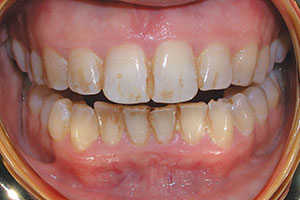 | 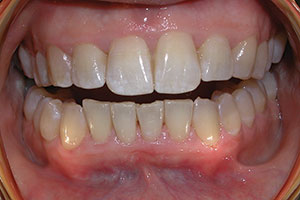 |
| Figure 3. An otherwise healthy patient with a severe extrinsic stain. In this case, either rubber cup polishing or air polishing is appropriate. | Figure 4. Following stain removal, the clinical appearance is much improved. Note the absence of trauma to the marginal gingiva. |
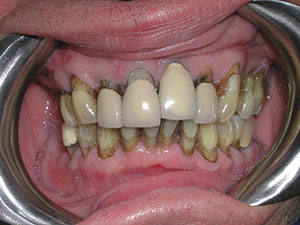 | 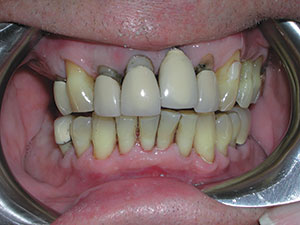 |
| Figure 5. A patient with a severe stain who, because of restorations and an exposed root surface, is not appropriate for air polishing. Conventional rubber cup polishing is recommended. | Figure 6. After the rubber cup polishing and complete stain removal. |
The use of ultrasonic hygiene instruments has been reported as a means to decrease pinch force and reduce procedure time.22 However, the vibration of ultrasonic instruments may still be a risk factor of MSD and CTS.10,17,21,23 Because effective hygiene treatment usually involves both hand and ultrasonic instruments, it is recommended that a combination of both techniques be used. In doing so, the duration of either technique is decreased, which can help to vary hand positioning, reduce muscle workload, and provide intermittent rest to hand muscles—specifically those involved with pinch force.10
A Fresh Perspective on an Old Idea?
Despite an appropriate perio/prophy ratio and hygiene:service mix, adult and child prophylaxes are commonly performed procedures.24 Using the techniques described to prevent MSDs and improve hand and wrist health offer the ability to help hygienists practice more comfortably, but is it possible to provide the same level of care while decreasing the amount of time hand muscles are in use? Alternating hand instrumentation with ultrasonic instrumentation is a first step, but an additional approach could be re-evaluating the routine nature of coronal polishing as a part of the prophylaxis procedure.
Since the late 1970s, the notion that every tooth during every routine prophylaxis should be polished has been replaced by the “selective polishing theory” that asserts that polishing should only be performed on teeth with extrinsic stains.25,26 An article by Pence et al27 reported an insignificant loss of enamel during the coronal polishing procedure, while a recent report highlights the idea that improper coronal polishing can cause significant damage to gingival tissues, exposed dentin and cementum, enamel, and especially restorations.28
Despite the theory of selective polishing, full-mouth polishing is routinely performed as a component of a dental prophylaxis. As a result of this reality, the term “selective polishing” has been updated to “essential selective polishing” to reinforce that if coronal polishing is to be routinely performed, then dental hygienists should select the most appropriate polishing or cleaning agents according to the patient’s individual needs.29,30
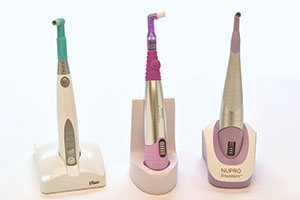 | 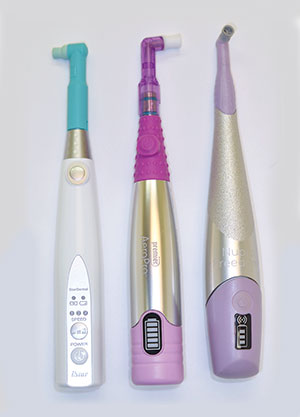 |
| Figure 7. Several examples of cordless prophy handpieces in their charging bases (left: iStar Cordless Prophylaxis Handpiece [DentalEZ] and Pivot Disposable Prophy Angle [Preventech], center: AeroPro Cordless Prophy Handpiece System and 2pro Disposable Prophy Angle [Premier Dental Products], right: NUPRO Freedom Cordless Prophy System and NUPRO Freedom Slim Disposable Prophy Angle [Dentsply Sirona]). | Figure 8. Several examples of cordless prophy handpieces (left: iStar Cordless Prophylaxis Handpiece [DentalEZ], center: AeroPro Cordless Prophy Handpiece System [Premier Dental Products], right: NUPRO Freedom Cordless Prophy System [Dentsply Sirona]). |
So, why has coronal polishing become a seemingly routine part of the patient’s prophylaxis appointment? Explanations may range from patient expectations to the oral healthcare provider’s desires to satisfy patients and provide the best care possible. The best case scenario is to reserve the coronal polishing procedure for the clinical situations that warrant it (eg, the removal of extrinsic stains, plaque, and biofilm), use the correct prophylaxis paste grit or cleaning agent, and avoid situations where it may be contraindicated (eg, acute periodontal infections, aesthetic restorations, tooth sensitivity, amelogenesis imperfecta, enamel demineralization, enamel hypocalcification, enamel hypoplasia, exposed cementum, and the absence of extrinsic stains)25,29 (Figures 3 and 4). By minimizing the vibration, cord pullback and drag, pinch force, and muscle fatigue associated with the use of traditional prophylaxis handpieces, hygienists can reduce muscle workload.31
It is worth mentioning that air polishing is another option for the removal of extrinsic stains and can be an important part of the hygiene armamentarium. The device typically comprises a handpiece similar to an ultrasonic insert that is connected via a hose to the unit and powder chamber. Compared to polishing with a rubber cup, the advantages of using air polishing include more efficient stain removal in less time, and with diminished dentin hypersensitivity and less operator fatigue.32,33 The contraindications to air polishing include certain medical conditions (eg, restricted sodium diets and respiratory, renal, or metabolic disease), use on root surfaces, use on composites or porcelains, and use around ceramic or metal orthodontic brackets25,32,34 (Figures 5 and 6). A significant hazard to air polishing is the increased risk of aerosols, which can be mitigated with universal precautions, use of high-volume evacuation, and antimicrobial rinses.35 Advances in the latest powders used in air polishing may diminish some of these contraindications in the future (eg, the use of glycine or the use of reduced air pressure).
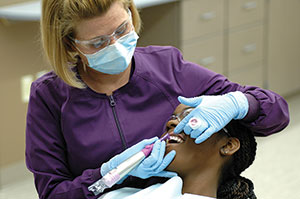 | 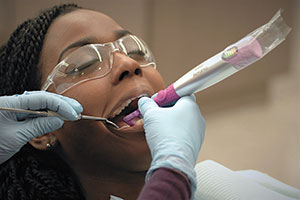 |
| Figure 9. A hygienist uses the AeroPro Cordless Prophy Handpiece for coronal polishing. Ergonomic factors of the prophy handpiece (eg, thick diameter, tactile grip, weight, and balance) combined with an extraoral finger rest can help to reduce muscle workload and fatigue. | Figure 10. A hygienist uses the AeroPro Cordless Prophy Handpiece for coronal polishing of the mandibular right teeth. Because there is no cord pullback with cordless prophy handpieces, polishing procedures can be performed more quickly and comfortably for the patient and provider. |
An Innovation in Prophy Handpieces
Technology has helped provide solutions for dental hygienists, specifically in larger-handled instruments and ultrasonic inserts with more effective tips for better control and precision (Figure 2). However, prophy handpieces have historically been air driven via tubing and may be heavy and unergonomic (eg, a slow-speed motor combined with a straight nose cone). Even dedicated prophy handpieces (eg, NUPRO RDH [Dentsply Sirona] and Ultrapro Tx Air [Ultradent Products]) may cause cord drag despite lighter weight and improved ergonomics.
In 2011, Dentsply Sirona introduced the first cordless prophy handpiece, originally named the Midwest RDH Freedom Cordless Prophy System (Dentsply Sirona) and more recently renamed to the NUPRO Freedom Cordless Prophy System (Dentsply Sirona). The original system included a motor component, metal sheath, charging base, and Bluetooth foot pedal, whereas the newer version can be used with or without a foot pedal.36 Both use proprietary disposable prophy angles.
In 2015, DentalEZ introduced the iStar Cordless Prophylaxis Handpiece, which is compatible with any prophy angle. The iStar is push-button operated; has variable speeds from 500 to 2,500 rpm; and is non-sterilizable, with infection prevention mediated by disposable sleeves. On the other hand, the NUPRO handpiece has variable speeds of up to 3,000 rpm and uses sterilizable sheaths with disposable barriers for infection prevention (Figures 7 and 8).
In 2019, Premier Dental Products introduced the AeroPro Cordless Prophy Handpiece System (Figures 7 and 8). It is compatible with any disposable prophy angle and is designed to allow the angle to be easily rotated 360° for improved intraoral access. As per the manufacturer, AeroPro is “ergonomic and lightweight with a well-balanced design, featuring a textured grip to help reduce pinch strength and hand fatigue” (Figures 9 and 10). It is controlled using a single button and features ChargeSMART technology for rapid charging and all-day battery life, and infection prevention is available via autoclavable sheaths and disposable barriers. It has 3 speeds of 500, 1,500, and 2,800 rpm.
A study by McCombs and Russell31 compared the muscle loads required during simulated tooth polishing using a corded vs a cordless handpiece. Electromyography (EMG) was used to measure the activity of 4 muscles involved in high pinch force. The results showed a reduced EMG for 3 out of the 4 muscles tested when the cordless handpiece was used, but the intensity of muscle workload between the corded and cordless handpieces was not statistically different. The biggest difference was an average 30-second reduction in polishing time with the cordless handpiece, which over the course of a workday would reduce duration of muscle workload, an important factor in preventing MSDs. The dental hygienists mostly preferred the cordless handpiece over the corded handpieces used in the study, and, when queried, they listed a lack of cord, weight and balance, and low noise as the main reasons for the preference.
CLOSING COMMENTS
Because of the nature of clinical dentistry—static posture, precise and repetitive motions, long work hours, and suboptimal ergonomics—all members of the clinical team are at risk for MSDs. Dental hygienists especially may be at an increased risk for MSDs compared to dentists and must practice preventive strategies to maintain hand and musculoskeletal health. Appreciating that an effective dental hygiene program is an integral component of a successful dental practice and comprehensive patient care, hygienists should seek clinical equipment that can reduce muscle workload and its duration.
Cordless prophy handpieces offer a meaningful innovation over their corded predecessors and should be considered a worthwhile upgrade for the safe and ergonomic delivery of hygiene care.
References
- Zaerian M. Musculoskeletal disorders and the impacts on the dental professional. Oral Health. February 1, 2009. https://www.oralhealthgroup.com/features/musculoskeletal-disorders-and-the-impacts-on-the-dental-professional/. Accessed February 12, 2019.
- Chopra A. Musculoskeletal disorders in dentistry—a review. JSM Dentistry. 2014;2:1032-1035.
- Hayes M, Cockrell D, Smith DR. A systematic review of musculoskeletal disorders among dental professionals. Int J Dent Hyg. 2009;7:159-165.
- Padhye NM, Padhye AM, Gupta HS. Effect of pre-procedural chair-side finger stretches on pinch strength amongst dental cohort—a biomechanical study. J Clin Diagn Res. 2017;11:ZC82-ZC85.
- McCombs GB, Russell DM. Reducing muscle workload. Dimens Dent Hyg. April 8, 2016. https://dimensionsofdentalhygiene.com/article/reducing-muscle-workload/. Accessed February 12, 2019.
- Burke FJ, Main JR, Freeman R. The practice of dentistry: an assessment of reasons for premature retirement. Br Dent J. 1997;182:250-254.
- World Health Organization. Preventing musculoskeletal disorders in the workplace. 2003. https://apps.who.int/iris/bitstream/handle/10665/42651/924159053X.pdf?sequence=1. Accessed February 12, 2019.
- Hamann C, Werner RA, Franzblau A, et al. Prevalence of carpal tunnel syndrome and median mononeuropathy among dentists. J Am Dent Assoc. 2001;132:163-170.
- Hayes MJ, Smith DR, Cockrell D. An international review of musculoskeletal disorders in the dental hygiene profession. Int Dent J. 2010;60:343-352.
- Valachi B. Getting the upper hand on pain: preventing hand and wrist pain syndromes on dental professionals. https://www.dentalacademyofce.com/courses/1878/pdf/handandwristpain.pdf.pdf. Accessed February 12, 2019.
- National Institute of Neurological Disorders and Stroke. Carpal tunnel syndrome fact sheet. July 13, 2018. https://www.ninds.nih.gov/Disorders/Patient-Caregiver-Education/Fact-Sheets/Carpal-Tunnel-Syndrome-Fact-Sheet. Accessed February 12, 2019.
- American Dental Association (ADA) Survey Center. Survey of current issues in dentistry: repetitive motion injuries. Chicago, IL: American Dental Association; 1997:2-8.
- Rice VJ, Nindl B, Pentikis JS. Dental workers, musculoskeletal cumulative trauma, and carpal tunnel syndrome: Who is at risk? A pilot study. Int J Occup Saf Ergon. 1996;2:218-233.
- ADA Center for Professional Success. Reducing hand pain. https://success.ada.org/en/wellness/reducing-hand-pain. Accessed February 12, 2019.
- Rucker LM, Sunell S. Musculoskeletal health status in B.C. dentists and dental hygienists: evaluating the preventive impact of surgical ergonomics training and surgical magnification [final report]. Vancouver, British Columbia, Canada: Workers’ Compensation Board of British Columbia; November 2000.
- Rucker LM, Sunell S. Ergonomic risk factors associated with clinical dentistry. J Calif Dent Assoc. 2002;30:139-146.
- Sanders MA, Turcotte CM. Strategies to reduce work-related musculoskeletal disorders in dental hygienists: two case studies. J Hand Ther. 2002;15:363-374.
- Morse TF, Michalak-Turcotte C, Atwood-Sanders M, et al. A pilot study of hand and arm musculoskeletal disorders in dental hygiene students. J Dent Hyg. 2003;77:173-179.
- Anton D, Rosecrance J, Merlino L, et al. Prevalence of musculoskeletal symptoms and carpal tunnel syndrome among dental hygienists. Am J Ind Med. 2002;42:248-257.
- Lalumandier JA, McPhee SD, Riddle S, et al. Carpal tunnel syndrome: effect on Army dental personnel. Mil Med. 2000;165:372-378.
- Johnson CR, Kanji Z. The impact of occupation-related musculoskeletal disorders on dental hygienists. Canadian Journal of Dental Hygiene. 2016;50:72-79.
- Dong H, Barr A, Loomer P, et al. The effects of finger rest positions on hand muscle load and pinch force in simulated dental hygiene work. J Dent Educ. 2005;69:453-460.
- Akesson I, Lundborg G, Horstmann V, et al. Neuropathy in female dental personnel exposed to high frequency vibrations. Occup Environ Med. 1995;52:116-123.
- Miller K. Five characteristics of a profitable dental hygiene department. April 6, 2017. http://www.speareducation.com/spear-review/2014/08/five-characteristics-profitable-dental-hygiene-department-part-ii. Accessed February 12, 2019.
- Sawai MA, Bhardwaj A, Jafri Z, et al. Tooth polishing: the current status. J Indian Soc Periodontol. 2015;19:375-380.
- Barnes CM. The science of polishing. Dimens Dent Hyg. November 1, 2009. http://www.dimensionsofdentalhygiene.com/2009/11_November/Features/The_Science_of_Polishing.aspx. Accessed February 12, 2019.
- Pence SD, Chambers DA, van Tets IG, et al. Repetitive coronal polishing yields minimal enamel loss. J Dent Hyg. 2011;85:348-357.
- Christensen GJ. Prophy pastes: helpful and harmful. Clinicians Report. 2018;11:1-8.
- Barnes C. Shining a new light on selective polishing. Dimens Dent Hyg. 2012;10:42-44.
- Barnes CM. Polishing. In: Wilkins EM, ed. Clinical Practice of the Dental Hygienist. 11th ed. Philadelphia, PA: Lippincott Williams & Wilkins; 2012.
- McCombs G, Russell DM. Comparison of corded and cordless handpieces on forearm muscle activity, procedure time and ease of use during simulated tooth polishing. J Dent Hyg. 2014;88:386-393.
- Graumann SJ, Sensat ML, Stoltenberg JL. Air polishing: a review of current literature. J Dent Hyg. 2013;87:173-180.
- Barnes CM. Air polishing: a mainstay for dental hygiene. https://www.dentalacademyofce.com/courses/2423/PDF/1305cei_Barnes_RDH_final.pdf. Accessed February 12, 2019.
- Johnson K. Air polishing has changed—so why hasn’t the dental hygiene curriculum? Dentistry IQ. August 16, 2016. https://www.dentistryiq.com/articles/2016/08/air-polishing-has-changed-so-why-hasn-t-the-dental-hygiene-curriculum.html. Accessed February 12, 2019.
- Gutmann ME. Air polishing: a comprehensive review of the literature. J Dent Hyg. 1998;72:47-56.
- Dryer M. Coronal polishing: the evolution of handpieces offers a new spin on dental hygiene services. RDH. June 1, 2017. https://www.rdhmag.com/articles/print/volume-37/issue-6/contents/coronal-polishing.html. Accessed February 12, 2019.
Dr. Goodchild is an associate clinical professor in the Department of Diagnostic Sciences at the Creighton University School of Dentistry in Omaha; an adjunct assistant professor in the Department of Diagnostic Sciences at the Rutgers School of Dental Medicine in Newark, NJ; and in private practice in Havertown, Pa. He can be reached at jgoodchild@premusa.com.
Disclosure: Dr. Goodchild is the director of clinical affairs for the Premier Dental Products Company in Plymouth Meeting, Pa.
Related Articles
Dentsply Sirona’s Aquasil Ultra+ Smart Wetting Impression Material Focuses on Key Clinical Benefits
Convenient Cleanup With Calibra Universal for Easier Cementation
Prevention of Musculoskeletal Disorders







